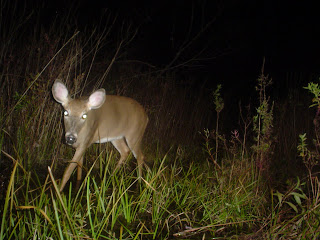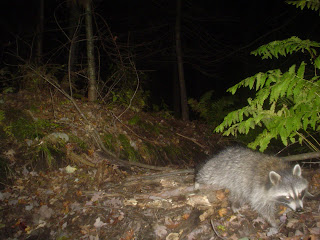Saturday, October 31, 2009
Mink runs/slides
near the fire pond at the edge of the Wilder Road apple orchard in
Bolton. She saw it twice within the span of about a week, in the same
exact place, at the same time of day. (Could be a good place for camera
placement.) Both times she got with 5 feet of it before they noticed
each other and the mink disappeared into the water. The photos above
show one of a number of run/slides that head into the water, in that
immediate area. The close-up shows the tunnel through the grass it made
as it enters the water.
Monday, October 19, 2009
Deer crossing a marshy area
I put out a remote camera on a deer trail through a wet, marshy area at
Delaney. Here are some of the images it captured over the rainy weekend.
When I went to retrieve the camera this morning, the entire area was
overrun with blackbirds. They were squawking in the trees, drinking
from the water, foraging through the leaves, and making quite a racket.
Wednesday, October 14, 2009
Elk scent marking
I spent the last week in Estes Park, Colorado, where the elk rut is in
full-swing. Several thousand elk descend upon the town outside Rocky
Mountain National Park each winter, and we saw single bulls with harems
of up to thirty cow elk bedding down in fields, wandering through town,
and acting generally oblivious to humans and cars. Every tree in town
is surrounded by wire fence to protect it from elk.
One one drive up into the park, we found this lone radio-collared bull
scent marking a sapling in a grove of trees. He was rubbing the broken
tree stem with the forehead gland between his antlers, and then licking
the tree where he had rubbed. This went on for as long as we watched
him, at least 20 minutes in the same spot.
The mule deer in the area are used to humans, and this one was munching
on vegetation 50 feet off our trail.
Active beaver lodge
hike, the one with the spectacular overlook of the reservoir. We
noticed that the beaver lodge (in the wetland at the beginning of the
hike) appeared freshly plastered with mud, suggesting that it is an
active lodge.
The question of how to tell if a lodge is active has come up many
times. As time passes and I accumulate "dirt time", I am beginning to
appreciate the variability in behavior within a given species. As for
beavers, it is often written that a lodge is not active in winter (in
northern climes) unless there is a cache of branches next to it, and not
active in summer unless it is plastered with mud. Well, I'm pretty sure
I've seen exceptions to both of these "rules", already. Anyway, the one
pictured above is pretty clearly active. Someone has been busy winter
proofing the house.
On the way back, we bushwhacked through the federated women's forest, in
the same general area that Susan, Dan, and I did last spring. But last
spring, as I recall, we were puzzled to see such an abundance porcupine
feeding sign on hemlocks, while there seemed to be very few porcupine
dens. However, last weekend, Bob and I seemed to be finding them
everywhere. We must have seen 7 or 8 winter dens.
Moose sign was abundant. In addition to the old sign, there was some
fresh scat at the end of the hike, near the clearcuts and the brook. I
think the beaver wetland in that area would be a good place to go moose
peeping in June, when moose spend more time feeding in wetlands.
Raccoons and Deer crossing muddy channel
I found this muddy channel cutting across a peninsula, and thought it
would be a great location to photograph beaver and otter taking a
shortcut. So far, that hasn't happened, but it produced several nice
photos of raccoons, deer, and squirrels going about their business.
Raccoon Latrine Tree
Three weeks ago, Janet and I scouted along the edge of the Delaney
wetlands, and found an enormous pile of raccoon scat beneath a large
white pine. We were so impressed, we left a camera to immortalize the
scat's creator. Over the course of the next three weeks, the camera
captured images of raccoons, white-tailed deer, squirrels, and a red fox.
This wasn't a particularly good camera placement - lots of leaves and
twigs to distract the focus, and the daytime shots (squirrels) are
pointing into the sun. Here are some of the "keepers" from
Raccoon Latrine Tree
Three weeks ago, Janet and I scouted along the edge of the Delaney
wetlands, and found an enormous pile of raccoon scat beneath a large
white pine. We were so impressed, we left a camera to immortalize the
scat's creator. Over the course of the next three weeks, the camera
captured images of raccoons, white-tailed deer, squirrels, and a red fox.
This wasn't a particularly good camera placement - lots of leaves and
twigs to distract the focus, and the daytime shots (squirrels) are
pointing into the sun. Here are some of the "keepers" from the camera.
Sunday, October 4, 2009
Muskrat eating platform
My brother and kayaked through the marsh at the north end of Delaney
today, and found many new, fresh cones of piled vegetation and bottom
muck along the shore. The ones closest to the boat launch were beaver
scent mounds, but as we got further along, and into the cattail marsh,
questions about beaver scent mounds vs. muskrat feeding platforms and
lodges came up again. We found some piles that were nothing more than
overturned lily pads (stems cut at 45 degrees, facing up) atop old
stumps. We found half-eaten white lily flowers, and flower stems that
looked like they had been eaten "artichoke-style".
The mounds that seemed most beaver-like were right out in the open - as
you'd expect a territorial marker would be. Back in the marsh, however,
the structures were mostly hidden 2-3 feet back in the cattails from the
open water.
We paddled over to one prominent "muskrat feeding platform", if that's
what it was, on the edge of the marsh. While it may have been
originally constructed as a feeding platform (it had a pile of lily
flower stems), it had been turned into a "muskrat eating platform".
There was a nice, neat pile of bones, and one we found fur and claws
that clearly indicated this was a muskrat carcass (or multiple
carcasses). There's a well-fed mink out there somewhere.















